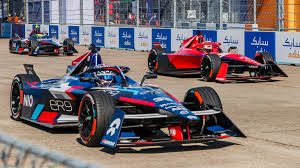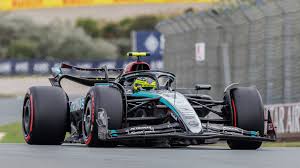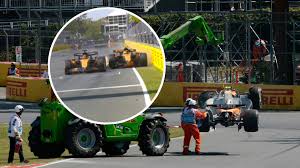The 2025 Canadian Grand Prix was nothing short of spectacular. Held on June 15 at Montreal’s iconic Circuit Gilles Villeneuve, this race delivered edge-of-the-seat action, showcasing the pinnacle of Formula 1 car technology and high-performance vehicles. In a thrilling finish, George Russell secured a historic victory for Mercedes, marking their resurgence in F1 car engineering and setting the stage for an electrifying 2025 season.
For auto enthusiasts, the 2025 Canadian Grand Prix wasn’t just about speed—it was a deep dive into automotive innovation, hybrid powertrains, and the relentless pursuit of perfection in modern race cars. Let’s break down the key moments, car performances, and why this race matters for the future of racing and road vehicles.
Race Recap: George Russell’s Triumph at the 2025 Canadian Grand Prix

The 2025 Canadian Grand Prix will be remembered as one of the most dramatic races in recent F1 history. George Russell, starting from pole position, held off a charging Max Verstappen by a mere 0.228 seconds—the closest finish in over a decade. Meanwhile, Mercedes’ rising star, 18-year-old Kimi Antonelli, claimed his first podium, proving that youth and cutting-edge F1 car engineering are a formidable combination.
Key Highlights from the 2025 Canadian GP:
- Russell’s Masterclass: A flawless drive under pressure, showcasing Mercedes’ improved aerodynamics and tire management.
- Verstappen’s Charge: Red Bull’s RB21 was a beast on straights but struggled in mid-speed corners.
- McLaren’s Disaster: Teammates Lando Norris and Oscar Piastri collided, leading to a safety car finish.
- Antonelli’s Breakthrough: The youngest podium finisher since Max Verstappen, signaling a new era in Formula 1 car technology.
With the 2025 Canadian Grand Prix reshaping the championship battle, let’s dive into the high-performance vehicles and engineering marvels that defined this race.
F1 Car Engineering: How Mercedes Dominated the 2025 Canadian Grand Prix

Mercedes’ W15 was the star of the 2025 Canadian Grand Prix, and its success boils down to three key innovations:
1. Aerodynamic Brilliance
The W15’s redesigned floor and front wing provided unmatched downforce, allowing Russell to maintain speed through Montreal’s tricky chicanes. Unlike previous seasons, the car avoided excessive tire degradation—a testament to Mercedes’ F1 car engineering breakthroughs.
2. Hybrid Power Unit Efficiency
The hybrid power unit in the W15 delivered seamless energy recovery, giving Russell an edge in acceleration out of slow corners. The MGU-K (Motor Generator Unit-Kinetic) and MGU-H (Motor Generator Unit-Heat) systems minimized turbo lag, a technology now influencing high-performance vehicles like the latest AMG hybrids.
3. Active Suspension & Cooling Upgrades
Mercedes’ new active suspension system kept tire temperatures stable, while an enhanced cooling setup prevented overheating—a critical factor in Russell’s consistent lap times.
🚗 Auto Tech Insight:
*The same energy recovery systems used in F1 are now appearing in road-legal high-performance vehicles, reducing emissions while boosting power.*
McLaren’s Meltdown: The Crash That Shook the 2025 Canadian Grand Prix

One of the biggest talking points from the 2025 Canadian Grand Prix was the Lap 47 collision between McLaren teammates Lando Norris and Oscar Piastri. Fighting for fourth, Norris misjudged an overtake, rear-ending Piastri and sending both into the barriers.
What Went Wrong?
- Aggressive Racing: Norris, desperate to close the gap to Piastri in the standings, took an unnecessary risk.
- Aero Damage: Both cars suffered significant floor damage, highlighting how fragile modern race cars can be.
- Team Tensions: The crash forced McLaren to enforce stricter team orders moving forward.
This incident not only impacted the 2025 Canadian Grand Prix results but also reshaped the championship battle, with Piastri extending his lead over Norris.
The Future of Formula 1 Car Technology: What This Race Means for Automotive Innovation
The 2025 Canadian Grand Prix wasn’t just a race—it was a showcase of how F1 car engineering influences the broader auto industry. Here’s what we learned:
1. Hybrid Systems Are the Future
The hybrid power unit in F1 is evolving rapidly, with advancements in battery efficiency and energy deployment. These innovations are trickling down to high-performance vehicles, making them faster and more sustainable.
2. Data-Driven Performance
Real-time telemetry, AI-assisted race strategies, and adaptive differentials are now standard in modern race cars. These technologies are being adopted by luxury automakers to enhance road car dynamics.
3. Youth-Friendly Cars
Kimi Antonelli’s podium proves that today’s F1 cars are more intuitive for young drivers, thanks to advanced assists like brake-by-wire and torque vectoring—features now seen in performance EVs.
Final Thoughts: Why the 2025 Canadian Grand Prix Matters

The 2025 Canadian Grand Prix was a landmark event for Formula 1 car technology, high-performance vehicles, and racing fans worldwide. George Russell’s win marked Mercedes’ return to dominance, while the race itself highlighted the incredible synergy between motorsport and automotive innovation.
As we look ahead to the next races in Austria and Silverstone, one thing is clear: F1 car engineering continues to push boundaries, shaping the future of both racing and road cars.
🏎️ What’s Next?
- Can Mercedes maintain their momentum?
- Will Red Bull solve their cornering issues?
- How will McLaren recover from their crash?